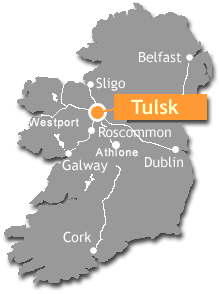IMBOLG IN IRELAND
The Gaelic/Celtic feast day, Imbolg, also known as Imbolc, or Lá Fheile Bríd, is the fire festival of springtime, a feast celebrating the end of the winter months, and to encourage the fertility, prosperity and security of the milder springtime. From Neolithic man to post-Christian Celt this date has been marked in one form or another for over 5,000 years.
The actual day on which the feast of Brigit, be it Goddess or Saint you honour, varies from the 31st of January to the 4th of February. Those Romano Celtic nations such as Bretons, Gauls and Britons tended to celebrate this festival according to the Spring equinoctial dates; Celtic Ireland however has a long tradition of marking the date itself, with Brigit’s eve falling on January 31st and Brigit’s Day on February 1st. The difference in attitude between pagan Celt and Roman toward astrology accounts for this difference in tradition. Whatever the day one chooses to mark, however, the feast of Brigit is celebrated with a common cause. The Saint Brigit has many of the same characteristics and attributes as her predecessor goddess, (the early Celtic church having deliberately endowed her with them to replace the almost indefatigable worship of Brigit Goddess!).
So what is this festival about? As an Equinoctial date it marks the beginning of the end of winter, a fact of immense significance to Neolithic man who would have gathered at Rathcroghan (Cruachú), or Newgrange (associated with Boann), to light the bonfires with which every feast of moment in the Irish calendar is celebrated. Those who had survived the harshest part of winter could relax a little – they were likely now to see the summer and plenty. Livestock would begin to reproduce, and again if they had survived this far, they would probably make it through to summer also. It was time to start considering repairs to the homesteads, look forward to the hunting and fishing activities of spring/summer, consider pairing off and marrying the tribes' young, look forward to the birth of children conceived during the long winter.
There's more! READ THE FULL ARTICLE HERE.
Later on, in the Iron Age as a Gaelic Festival, it is thought that at this time the people were predominantly occupied with issues of Fertility, Love, Marriage, Purity, Cleansing and Healing. Surviving folk-customs underpin that this time of year was one for lovers, for arranging marriages, for rites of healing, for purifying with water and fire. The “St. Valentine Day” rituals were originally part of the Brigit Celebrations. Brigit was the patron of crafts, spinning, weaving, sewing, baking, grinding, mills, health, livestock, the Hearth, cooking. As art of her “healing” role there are sacred wells and springs all over Ireland and Britain, dedicated to the healing powers of Brigit. She is also associated with fire rituals: the bonfires lit on Brigit’s eve, plus the tradition of purifying livestock, woman and new born children by passing a burning rush brand over, under and around them. Grown-ups leapt the bonfire for the same reason. Fire was brought around the house, and water from a sacred well sprinkled around the house, after it has been thoroughly cleaned. Girdles of rushes, known as Bríd’s Girdle were made, for people and livestock, through which they were passed three times in order to protect against illness.
(See Roscommon Well Wishers on Facebook for local info on holy wells)
Spring Cleaning was a product of these ancient customs. The house had to be cleaned from top to bottom, and aired, a sensible custom when communal living at close quarters during the winter was the norm; indeed the idea of spring-cleaning probably did help protect against - and get rid of - all manner of germs! Psychologically it symbolised a fresh new season, time to get out and about, move around the countryside again, to give and receive visits.
There's more! READ THE FULL ARTICLE HERE.
Article contributed by Geraldine Byrne, commissioned for The Mysteries teaching website, Copyright 2002. Used with permission.



No comments:
Post a Comment